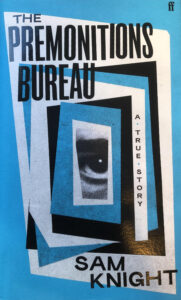The Premonitions Bureau: A True Story by Sam Knight. Faber, London, 2022. ISBN: 978-0-571-35756-7. 249 pp.
Inspired by several alleged premonitions of the 1966 Aberfan tragedy, psychiatrist John Barker had the idea to set up a kind of national register of such before-the-event predictions. His hope was to prevent disasters such as that which occurred at Aberfan by providing a bureau containing a ‘hotline’ that people could ring with details of their premonitions such as time, place, nature of event, and so on. A study of 723 such predictions made within the bureau’s first year of operations revealed a ‘hit rate’ of 3% and by the time it closed in the early 1970s the newspaper-based operation which Barker set up with journalist Peter Fairley had received 1200 checkable premonitions without issuing a single alert. No disasters were ever averted.
Such underwhelming statistics might suggest that The Premonitions Bureau is rather thin gruel, but Knight’s deftness in telling the story ensures that this is not the case. Far from it. In fact, given John Barker’s eclectic and somewhat maverick interests – and the book is, essentially, about him – we end up being introduced to a wide range of themes over 249 very readable pages: the terrible events at Aberfan on 28th October 1966, the nature of time and prediction, the changing nature of psychiatry in the 1960s, the nocebo effect, the possibility or otherwise of being scared to death, and the nature of ‘second sight’ amongst others. Prominence is given to several of Barker’s most talented ‘seers’, and whilst their efforts in preventing tragedies were all failures, they appear on occasion to have come uncannily close to predicting, if not preventing, certain events, such as the Hither Green rail accident on 5th November 1967. In this instance, the nature of the event and the approximate location were provided, but nothing more. Too little to prevent the injuries to the seventy-eight who were hurt, but just enough to suggest that something was foreseen. The same odd mixture of ‘hits’ and ‘misses’ that we find within the pronouncements of many psychics working in other contexts, in fact.
My only criticism of this far-ranging study is that it ranges just a little too far at times, distracting from the subject and straying a little too close, on occasion, to irrelevance. But Sam Knight tells a good tale and even when some anecdotes don’t really add much to it they still provide much to ponder. John Barker’s death on 20th August 1968 at the tragically early age of forty-four was not the end of the bureau, but it was certainly the end of an unusual and interesting man. A driven one, too, who richly deserved the fine memorial that Sam Knight has skilfully provided.
